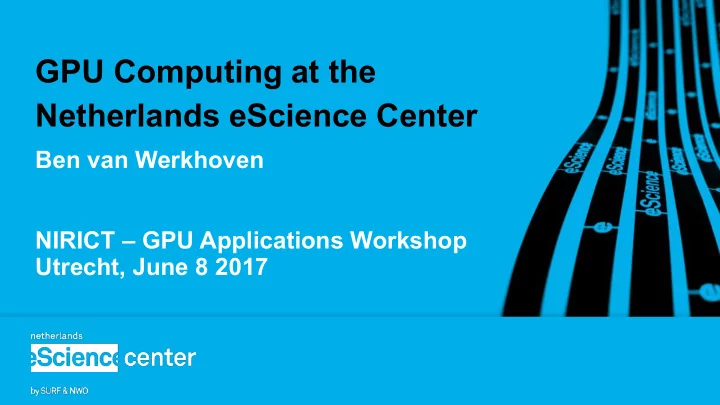

GPU Computing at the Netherlands eScience Center Ben van Werkhoven NIRICT – GPU Applications Workshop Utrecht, June 8 2017
Climate Modeling Radio Astronomy GPU Applications Super-resolution Microscopy Astro-particle Physics Life Sciences Computational Linguistics Digital Forensics
How we work Yearly calls for proposals Accepted projects receive: - 250K to hire Postdoc or PhD student - 2.5FTE eScience Research Engineers
Projects started in 2017 Data mining DIRAC - tools for abrupt Distributed Radio climate change Astronomical Computing Methodology and Accelerating ecosystem for Astronomical many-core Applications 2 programming
Real-time detection of neutrinos from the distant Universe
KM3NeT – Neutrino Telescope • Huge instrument at the bottom of the Mediterranean Sea • Pretty high data rate due to background noise from bioluminescence and Potassium-40 decay • Current event detection / reconstruction happens on pre-filtered data (so called L1 hits) • Our goal: Work towards event detection based on unfiltered data (so called L0 hits)
Correlating hits Correlation matrix • Hits are correlated based on their time and location • Correlations can only occur in a small window of time • Density of the narrow band depends on correlation criterion in use hit no. Try-out two designs: • Dense pipeline that stores the narrow band as a table • Sparse pipeline that stores the matrix in compressed sparse row (CSR) form hit no.
Data representation N N 1500 N N N – Dense N 1500 correlations on the GPU correlation matrix table N CSR format # correlations – Sparse column indices N N start of row correlation matrix
Comparing performance
Super-resolution microscopy
Super-resolution microscopy • Collect a large number of images from fluorescence microscope • Localize fluorophores using fitting code • Create single super-resolution image from all localized fluorophores • Segment all individual molecules in the image Fluorescence microscope • Create single reconstruction by combining identical copies in the data
Existing GPU code • GPU code for maximum likelihood estimation developed in 2009-2010 – ”Fast, single -molecule localization that achieves theoretically minimum uncertainty ” Smith et al. Nature Methods (2010) • Estimates the locations and several other parameters of points in noisy image data for various fitting schemes and pixel area sizes • State of the code: – Each thread worked on exactly one fitting – Pixel area analyzed by single thread is 7x7, 19x19, and expected to grow in future – Requires many registers and a lot of shared memory per thread block – Results in low utilization on modern GPUs – Multiple fitting schemes implemented with lots of code duplication
New parallelization • One fitting is now computed by a whole thread block cooperatively • Used CUB library for thread block-wide reductions • Code quality – Used function templates to de-duplicate code between different fitting methods – Wrote scripts for testing and tuning of device functions and kernels • Results – Currently, speedup of 5.8x to 6.6x over old GPU code on Nvidia GTX Titan X – Code can handle arbitrary pixel area per fitting – Makes it possible to do termination detection – Easier to maintain and extend the code with new fitting schemes
Lessons Learned
Software Engineering Practice “Throw all good practices out of the window for the sake of high performance” • Examples: – Thousands of code lines in a single function – Only acronyms as variable names – No comments or external documentation about the code – Unnecessary optimization • Recommendations: – Start GPU code from simple code – Write and use tests – Write C++ and not C, whenever possible – Trust the compiler to handle simple stuff
Evaluating results Results from the CPU and GPU codes are not bit-for-bit the same • GPUs today implement the IEEE standard just like CPUs • CPU compilers sometimes more aggressive than GPU compilers • Fused multiply-add rounds differently • Floating-point arithmetic is not associative Things to keep in mind • It depends on the application whether bit-for-bit difference is a problem • Testing with random input can give a false sense of correctness
Talking about performance • Many computer scientists I know think – The only way to properly way to discuss GPU performance is to fully optimize and tune for both CPU and GPU – Then (and only then) you are allowed to say anything about GPU performance – Answering the question: “Which architecture performs the best for this application?” • Many scientists from others fields that I work with just want to know: – “How much faster is that Matlab /Python code I gave you on the GPU?”
Summary • Choose your starting point carefully • High-performance and high quality software can co-exist • Application dependent if small differences in results is a problem • When talking about performance, be very clear on what is compared to what www.esciencecenter.nl Ben van Werkhoven b.vanwerkhoven@esciencecenter.nl
Project Partners
Recommend
More recommend